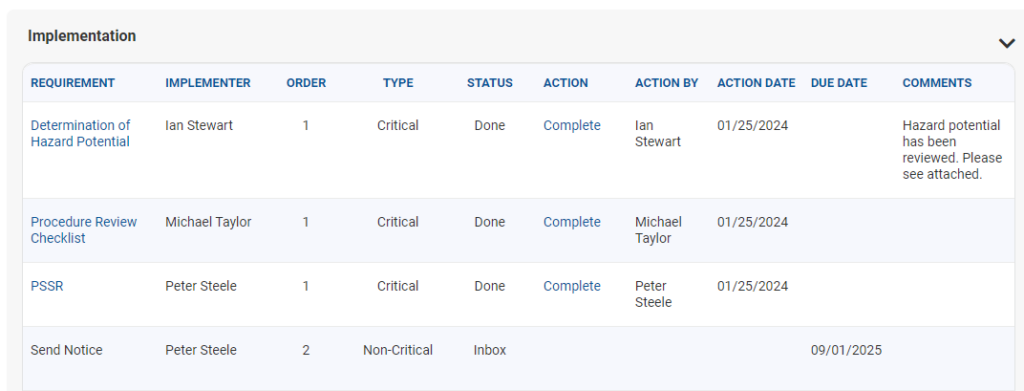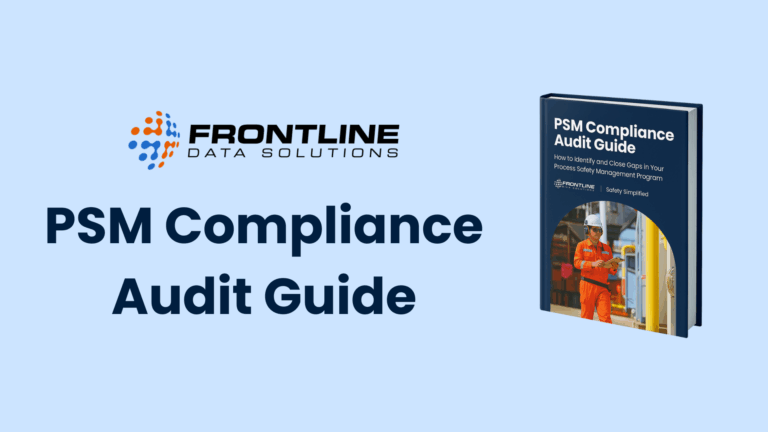Management of change includes five separate requirements for covered processes. You can satisfy these requirements with a manual approach, but for many companies, a digital workflow is better for documentation and overall compliance. Frontline MOC software is a user-friendly tool for simplifying compliance with PSM criteria and other forms of operational change management.
Free template!
Download this free PSM audit template to get all the PSM criteria in checklist format, so you can complete a full review.
Written MOC procedures
The first requirement of MOC is to have written procedures for managing changes to the following variables in PSM-covered processes:
- Process chemicals
- Technology
- Equipment
- Procedures
- Facilities
Frontline MOC software makes creating written procedures easy by providing a structured workflow for your team to follow each time. You can use this workflow as the basis for your written MOC plan which should describe how your team will review, approve, implement, and roll out changes.
Considerations before implementation
In paragraph two, OSHA states that you must make five considerations before you implement any changes:
- Technical basis for the change
- Modifications to operating procedures
- Authorization requirements for the proposed change
- Impact of change on safety and health
- Necessary time for the change
Frontline MOC software meets these criteria by requiring users to fill out fields for the technical basis, expected completion date, and environmental and safety impact of the change. It also allows them to describe the equipment affected by the change.
The authorization requirements capability is built into the workflows. When setting up MOCs, users can require different members of the team to sign off on certain action items or steps in the process.
Frontline EHS for MOC process improvement
Learn how to improve your site’s entire MOC process with Frontline EHS software.
Time: 25 minutes
Employee awareness and training
Prior to startup, OSHA requires companies to ensure that all employees and contract workers who work in PSM-covered processes receive information about upcoming changes. This applies to anyone who interacts with the process—including workers who perform maintenance on the equipment. Also, the standard says that these employees must receive training on the new or updated process.
With Frontline MOC, users can create implementation action items for sending out PSM information to everyone within covered processes. You can either log the training requirements within the MOC implementation task log or use Frontline LMS to schedule and assign topics.
The benefit of using change management software for these criteria is that it documents everything automatically. Once you send out the information and mark the action item complete, you’ve documented compliance. Since it’s all built into the workflows, doing the recordkeeping doesn’t cost any extra time and makes the information more accessible.
Updating procedures
The last component of management of change is updating operating procedures or practices affected by operational changes. This applies to procedures required in both paragraphs D and F of the PSM standard.
To meet this PSM criteria, create an implementation action item for updating procedures in Frontline MOC. There, you can include notes on which procedures and practices you updated, who made the updates, and when. You can even upload the documents themselves for reference. That way, all the information is easy to track and access.
Here’s an example of what this looks like in the MOC documentation:

Frontline MOC can be used as a PSM software provides the structure your team needs to execute changes effectively and efficiently. But like any software platform, you only get out of it what you put in. The key to management of change is quality documentation practices. Focus on improving your team’s documentation skills so that your data is cleaner and easier to analyze. That way, you’ll have better learnings from each implementation and find more ways to improve in the future.





